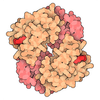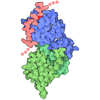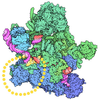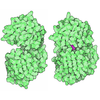[日本語] English
 万見
万見- EMDB-19049: Cryo-EM structure of hexameric BTB domain of Drosophila CG6765 protein -
+ データを開く
データを開く
- 基本情報
基本情報
| 登録情報 |  | |||||||||
|---|---|---|---|---|---|---|---|---|---|---|
| タイトル | Cryo-EM structure of hexameric BTB domain of Drosophila CG6765 protein | |||||||||
 マップデータ マップデータ | Main map with RELION Blush regularisation applied | |||||||||
 試料 試料 |
| |||||||||
 キーワード キーワード | DNA-binding / transcription regulation / oligomerization / TRANSCRIPTION | |||||||||
| 機能・相同性 |  機能・相同性情報 機能・相同性情報developmental process involved in reproduction / animal organ development / neuron development / regulation of transcription by RNA polymerase II / zinc ion binding / nucleus 類似検索 - 分子機能 | |||||||||
| 生物種 |  | |||||||||
| 手法 | 単粒子再構成法 / クライオ電子顕微鏡法 / 解像度: 3.3 Å | |||||||||
 データ登録者 データ登録者 | Bonchuk AN / Naschberger A / Baradaran R | |||||||||
| 資金援助 |  ロシア, 1件 ロシア, 1件
| |||||||||
 引用 引用 |  ジャーナル: Elife / 年: 2024 ジャーナル: Elife / 年: 2024タイトル: The Arthropoda-specific Tramtrack group BTB protein domains use previously unknown interface to form hexamers. 著者: Artem N Bonchuk / Konstantin I Balagurov / Rozbeh Baradaran / Konstantin M Boyko / Nikolai N Sluchanko / Anastasia M Khrustaleva / Anna D Burtseva / Olga V Arkova / Karina K Khalisova / ...著者: Artem N Bonchuk / Konstantin I Balagurov / Rozbeh Baradaran / Konstantin M Boyko / Nikolai N Sluchanko / Anastasia M Khrustaleva / Anna D Burtseva / Olga V Arkova / Karina K Khalisova / Vladimir O Popov / Andreas Naschberger / Pavel G Georgiev /   要旨: BTB (bric-a-brack, Tramtrack, and broad complex) is a diverse group of protein-protein interaction domains found within metazoan proteins. Transcription factors contain a dimerizing BTB subtype with ...BTB (bric-a-brack, Tramtrack, and broad complex) is a diverse group of protein-protein interaction domains found within metazoan proteins. Transcription factors contain a dimerizing BTB subtype with a characteristic N-terminal extension. The Tramtrack group (TTK) is a distinct type of BTB domain, which can multimerize. Single-particle cryo-EM microscopy revealed that the TTK-type BTB domains assemble into a hexameric structure consisting of three canonical BTB dimers connected through a previously uncharacterized interface. We demonstrated that the TTK-type BTB domains are found only in Arthropods and have undergone lineage-specific expansion in modern insects. The genome encodes 24 transcription factors with TTK-type BTB domains, whereas only four have non-TTK-type BTB domains. Yeast two-hybrid analysis revealed that the TTK-type BTB domains have an unusually broad potential for heteromeric associations presumably through a dimer-dimer interaction interface. Thus, the TTK-type BTB domains are a structurally and functionally distinct group of protein domains specific to Arthropodan transcription factors. | |||||||||
| 履歴 |
|
- 構造の表示
構造の表示
| 添付画像 |
|---|
- ダウンロードとリンク
ダウンロードとリンク
-EMDBアーカイブ
| マップデータ |  emd_19049.map.gz emd_19049.map.gz | 19.8 MB |  EMDBマップデータ形式 EMDBマップデータ形式 | |
|---|---|---|---|---|
| ヘッダ (付随情報) |  emd-19049-v30.xml emd-19049-v30.xml emd-19049.xml emd-19049.xml | 19.1 KB 19.1 KB | 表示 表示 |  EMDBヘッダ EMDBヘッダ |
| FSC (解像度算出) |  emd_19049_fsc.xml emd_19049_fsc.xml | 15.9 KB | 表示 |  FSCデータファイル FSCデータファイル |
| 画像 |  emd_19049.png emd_19049.png | 113.7 KB | ||
| マスクデータ |  emd_19049_msk_1.map emd_19049_msk_1.map | 343 MB |  マスクマップ マスクマップ | |
| Filedesc metadata |  emd-19049.cif.gz emd-19049.cif.gz | 5.9 KB | ||
| その他 |  emd_19049_additional_1.map.gz emd_19049_additional_1.map.gz emd_19049_half_map_1.map.gz emd_19049_half_map_1.map.gz emd_19049_half_map_2.map.gz emd_19049_half_map_2.map.gz | 17.6 MB 275.5 MB 275.1 MB | ||
| アーカイブディレクトリ |  http://ftp.pdbj.org/pub/emdb/structures/EMD-19049 http://ftp.pdbj.org/pub/emdb/structures/EMD-19049 ftp://ftp.pdbj.org/pub/emdb/structures/EMD-19049 ftp://ftp.pdbj.org/pub/emdb/structures/EMD-19049 | HTTPS FTP |
-関連構造データ
| 関連構造データ |  8rc6MC M: このマップから作成された原子モデル C: 同じ文献を引用 ( |
|---|---|
| 類似構造データ | 類似検索 - 機能・相同性  F&H 検索 F&H 検索 |
- リンク
リンク
| EMDBのページ |  EMDB (EBI/PDBe) / EMDB (EBI/PDBe) /  EMDataResource EMDataResource |
|---|---|
| 「今月の分子」の関連する項目 |
- マップ
マップ
| ファイル |  ダウンロード / ファイル: emd_19049.map.gz / 形式: CCP4 / 大きさ: 343 MB / タイプ: IMAGE STORED AS FLOATING POINT NUMBER (4 BYTES) ダウンロード / ファイル: emd_19049.map.gz / 形式: CCP4 / 大きさ: 343 MB / タイプ: IMAGE STORED AS FLOATING POINT NUMBER (4 BYTES) | ||||||||||||||||||||||||||||||||||||
|---|---|---|---|---|---|---|---|---|---|---|---|---|---|---|---|---|---|---|---|---|---|---|---|---|---|---|---|---|---|---|---|---|---|---|---|---|---|
| 注釈 | Main map with RELION Blush regularisation applied | ||||||||||||||||||||||||||||||||||||
| 投影像・断面図 | 画像のコントロール
画像は Spider により作成 | ||||||||||||||||||||||||||||||||||||
| ボクセルのサイズ | X=Y=Z: 0.729 Å | ||||||||||||||||||||||||||||||||||||
| 密度 |
| ||||||||||||||||||||||||||||||||||||
| 対称性 | 空間群: 1 | ||||||||||||||||||||||||||||||||||||
| 詳細 | EMDB XML:
|
-添付データ
-マスク #1
| ファイル |  emd_19049_msk_1.map emd_19049_msk_1.map | ||||||||||||
|---|---|---|---|---|---|---|---|---|---|---|---|---|---|
| 投影像・断面図 |
| ||||||||||||
| 密度ヒストグラム |
- 試料の構成要素
試料の構成要素
-全体 : Hexameric BTB domain of CG6765 protein
| 全体 | 名称: Hexameric BTB domain of CG6765 protein |
|---|---|
| 要素 |
|
-超分子 #1: Hexameric BTB domain of CG6765 protein
| 超分子 | 名称: Hexameric BTB domain of CG6765 protein / タイプ: cell / ID: 1 / 親要素: 0 / 含まれる分子: all |
|---|---|
| 由来(天然) | 生物種:  |
-分子 #1: BTB domain of CG6765 protein
| 分子 | 名称: BTB domain of CG6765 protein / タイプ: protein_or_peptide / ID: 1 / コピー数: 6 / 光学異性体: LEVO |
|---|---|
| 由来(天然) | 生物種:  |
| 分子量 | 理論値: 14.543481 KDa |
| 組換発現 | 生物種:  |
| 配列 | 文字列: AENYHLKWDS HLTYLNSSIA TLYKNEKFAD VVLYSSYNSS GIPSDIPTVG ISAHKFILSA SSQFFATMFE TAPITNPNGV LYVVLPPDL SHRAIQILVQ YMYSGEATVS NDILNEVLRG GEILKIRGLC RT UniProtKB: Uncharacterized protein, isoform A |
-実験情報
-構造解析
| 手法 | クライオ電子顕微鏡法 |
|---|---|
 解析 解析 | 単粒子再構成法 |
| 試料の集合状態 | cell |
- 試料調製
試料調製
| 濃度 | 10 mg/mL |
|---|---|
| 緩衝液 | pH: 7.4 / 詳細: 20mM Tris, pH 7.4, 50mM NaCl, 1mM DTT |
| グリッド | 材質: COPPER / 支持フィルム - 材質: CARBON / 支持フィルム - トポロジー: HOLEY / 前処理 - タイプ: GLOW DISCHARGE / 前処理 - 時間: 60 sec. |
| 凍結 | 凍結剤: ETHANE / チャンバー内湿度: 100 % / チャンバー内温度: 277 K / 装置: FEI VITROBOT MARK IV |
- 電子顕微鏡法
電子顕微鏡法
| 顕微鏡 | TFS KRIOS |
|---|---|
| 撮影 | フィルム・検出器のモデル: TFS FALCON 4i (4k x 4k) 実像数: 9757 / 平均露光時間: 4.1 sec. / 平均電子線量: 40.3 e/Å2 |
| 電子線 | 加速電圧: 300 kV / 電子線源:  FIELD EMISSION GUN FIELD EMISSION GUN |
| 電子光学系 | 照射モード: SPOT SCAN / 撮影モード: BRIGHT FIELD / 最大 デフォーカス(公称値): 3.0 µm / 最小 デフォーカス(公称値): 0.4 µm / 倍率(公称値): 165000 |
| 試料ステージ | 試料ホルダーモデル: FEI TITAN KRIOS AUTOGRID HOLDER ホルダー冷却材: NITROGEN |
| 実験機器 |  モデル: Titan Krios / 画像提供: FEI Company |
+ 画像解析
画像解析
-原子モデル構築 1
| 初期モデル | Chain - Source name: AlphaFold / Chain - Initial model type: in silico model |
|---|---|
| 得られたモデル |  PDB-8rc6: |
 ムービー
ムービー コントローラー
コントローラー












 Z (Sec.)
Z (Sec.) Y (Row.)
Y (Row.) X (Col.)
X (Col.)





























